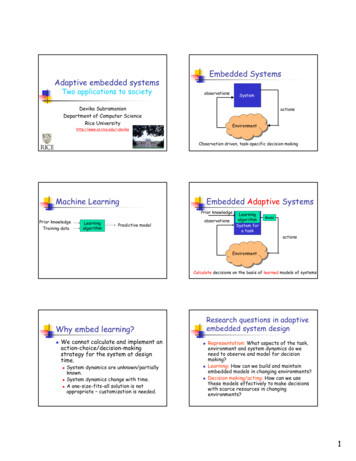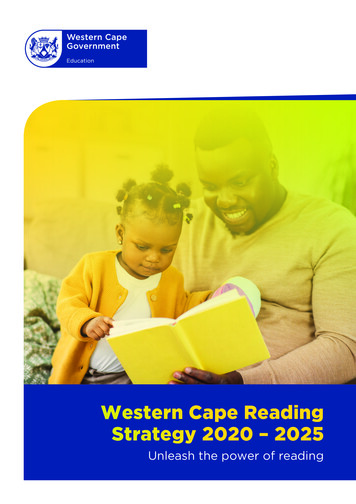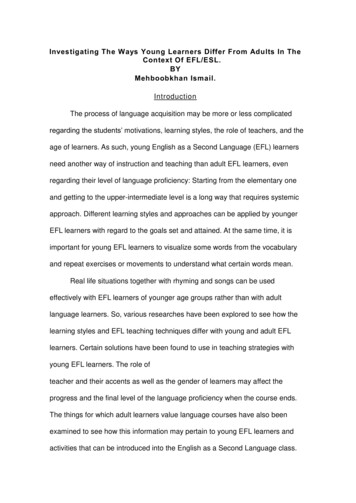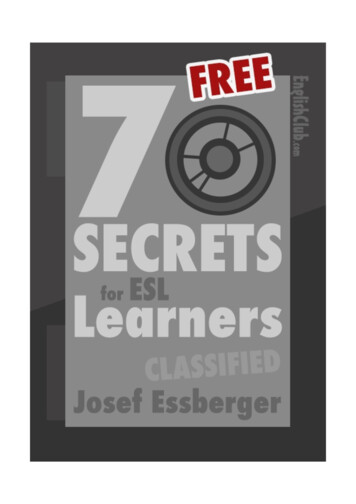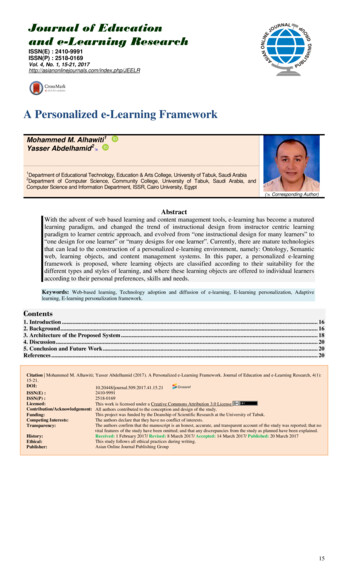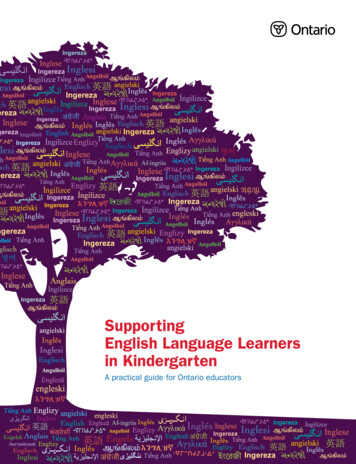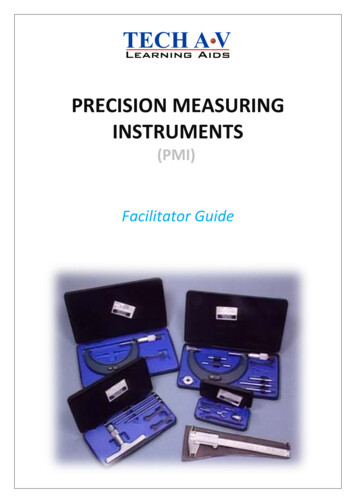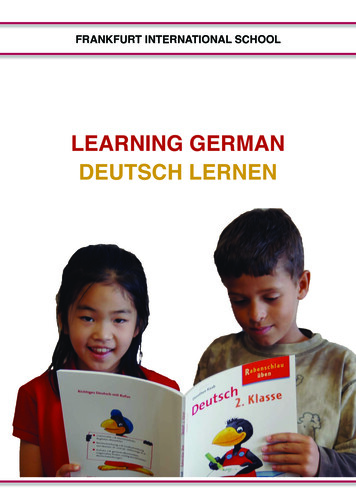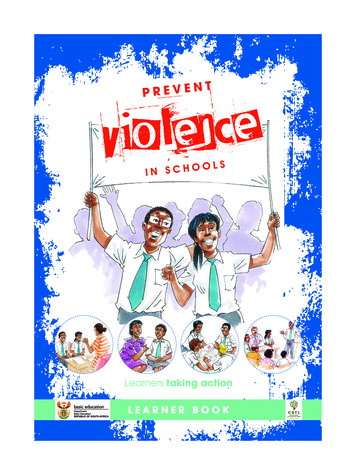
Transcription
Learners taking actionLEARNER BOOK
ACKNOWLEDGEMENTSISBN: 978-0-9922031-5-3The programme Prevent violence in schools is part of a wider initiative, Safer South Africa for Women andChildren, launched in 2012 by Save the Children South Africa, the United Nations Children’s Fund (UNICEF) andthe United Nations Population Fund (UNFPA), in partnership with the Department of Basic Education and fundedby DfiD. Prevent violence in schools focuses on enabling and supporting learners to take action to preventviolence in their own schools.Prevent violence in schools falls within the overarching framework of the Care and Support for Teaching andLearning (CSTL) Programme. CSTL offers a comprehensive, coordinated, multi-sectoral response to addressingbarriers to learning and development for learners and educators. Its goal is to realise the education rights of allchildren through schools becoming inclusive centres of learning, care and support. The DBE has identified tenpriority intervention areas in which there must be delivery with respect to care and support activities across allSouth African schools. These priorities respond to the legal and developmental policy and legislative mandateplaced on the DBE and have been shown to be effective at securing inclusion and addressing the barriers currentlyfacing many vulnerable learners and groups of marginalised children. The ten priority areas are: A Rights-basedand Socially Inclusive and Cohesive School; Nutritional Support; Health Promotion; Infrastructure, Water andSanitation; Social Welfare Services; Psychosocial Support; Safety and Protection; Curriculum Support; Co-curricularSupport and Material Support.The programme materials were developed by writers from Save the Children South Africa and MIET Africa inpartnership with DBE and UNICEF. Content development was informed by a workshop with learners held in theFree State during 2014, and the materials were reviewed at various stages of development by a review teamdrawn from all the partner organisations. This material will be further field tested with district officials from 86 districtsand thereafter finalised. Please send all comments and suggestions to the Department of Basic Education, PrivateBag X895, Pretoria, 0001.Progamme materials include two publications: Prevent violence in schools. Learners taking action. Learner book Prevent violence in schools. Learners taking action. Facilitator and mentor guideMaterials review team: Dululu Hlatshaneni (DBE); Nokuthula Prusent (UNICEF);Gilles Virgili and Solly Matile (Save the Children); Jan van Zyl and Maureen King (MIET Africa)MIET Africa materials development and production team: Jane Jackson (main writer);Shirley Moon (main editor); Beverley Dyason; Daniela McCulloughIllustrations: A. Valentim JuniorDesign and layout: sarahscottdesignPublished by MIET Africawww.miet.co.zaThe DBE acknowledges the generous support of UNICEF for funding the developmentof the materials and programme implementation.2
LEARNER BOOKCONTENTSAcronymsGlossary45Module 1: Introduction to Prevent violence in schoolsWhat is the Prevent violence in schools programme?What is in this Learner book and how will you use it?Ground rulesWe don’t all see things in the same way66789Module 2: Understanding violenceWhat is violence?Defining violenceIdentifying different types of violenceDefining different types of violence1010121315Module 3: Gender-based violenceUnderstanding gender and gender-based violenceBoth males and females can be victims of GBV202022Module 4: Analysing violenceUnderstanding causes and consequencesThe effects of violence242426Module 5: Reporting violenceIssues in reporting violenceWhat to do if you are rapedSome tips about reporting rape to the policeReporting sexual abuse at schoolUsing an incident report form282829303233Module 6: My school, my realityMapping safe and unsafe placesThe problem tree343435Module 7: Taking actionThe nine action stepsWorking through the nine action stepsStep 1: get the support of the principal and a teacher championStep 2: identify a learner school safety team and investigate violence at schoolStep 3: develop a visionStep 4: share findings with principal and SGBStep 5: inform all learners at assembly and ask for supportStep 6: plan violence-prevention activitiesStep 7: implement violence-prevention activitiesStep 8: report on achievementsStep 9: plan a new round of action363636383940414243464748References513
ACRONYMSARV. AntiretroviralCBO. Community-Based OrganisationDBE. Department of Basic EducationFBO. Faith-Based OrganisationGBV. Gender-Based ViolenceMAP. Morning-After PillNGO. Non-Governmental OrganisationNSSF. National School Safety FrameworkSACE. South African Council of EducatorsSAPS. South African Police ServiceSGB. School Governing BodyUNFPA . United Nations Population FundUNICEF . United Nations Children’s FundVEP4. Victim Empowerment Programme
GLOSSARYGenderIdeas about how men and women should behave and what roles andresponsibilities they should take in lifeGender stereotypesFixed ideas about how men/boys and women/girls behave. Suchstereotypes are not trueLearners’ Code of ConductA document that sets out what behaviour is acceptable and notacceptable in the schoolMentorAn experienced person who advises and supports you over a period oftimeMorning-After Pill (MAP)An emergency contraceptive pill that may prevent pregnancy if takenas soon as possible, and within 72 hours (3 days) after sexPerpetratorA person who does something bad/wrong/illegal, e.g. uses violenceagainst someonePost-exposure prophylaxisA treatment that is used after sexual abuse to reduce the risk of HIV(PEP)infection. This treatment should be taken as soon as possible, andwithin 72 hours (3 days) after the incidentProblem treeA tool to help understand causes and consequences (results) of a problemissue (e.g. violence)RapeAny sexual act, or attempted sexual act, that involves someone puttinga penis or a finger or any object into the mouth, anus or vagina of someoneelse against their willSchool safety committeeA group that has been selected to look at safety in a school and has theduty to take disciplinary action against violence at school; it should includelearner representatives such as a member or members of the school safetyteamSchool safety teamA group of learners who are committed to working together to take actionagainst violence in their schoolSugar daddy/mommyAn older man or woman, who gives money or gifts to a younger personin return for sexual favoursVictimA person who is harmed because of something bad that happens tothem e.g. violence/crime/sexual abuse. We can also call this person asurvivor, to show that they have power to get over the bad experienceand healVictim EmpowermentA programme put in place by SAPS to support victims/survivors of sexualProgramme (VEP)abuse when they report the incidentViolenceWhen we use (or threaten to use) power or force to cause physical and/orpsychological harm to ourselves or others; violence is intentional (doneon purpose)5
MODULE 1Introduction toPrevent violencein schoolsWhat is the Prevent violence in schools programme?Prevent violence in schools is a programme in whichPrevent violence in schools deals with different kindsyou, the learner, will take the lead in working to endof violence that learners often experience, such asthe problem of violence in our schools. This is ancorporal punishment, bullying and especially gender-important task because violence has increased in ourbased violence (GBV). GBV is violence that happenscountry and is doing great harm. Violence damagesmainly because women and girls are not treated aspeople, families, schools and communities. It hurtsequal to men and boys in our society. Widespread GBVpeople’s minds and emotions as well as their bodies. Itmakes it more and more difficult for men and women,puts young people’s education and their future lives atboys and girls to have good relationships and build theirrisk. This should not happen: all learners need a safelives and their communities together. It threatensschool environment where they can learn without fearpeople’s lives, not only through the violence itself, butof violence and enjoy good-quality education.also because HIV and AIDS spreads much more easilywhen there is forced and/or unsafe sex.This programme sees violence as a human rights issuebecause it threatens your rights as a child and a learner.It is your right to have life, to be treated with respect,You have already started to Prevent violenceto get an education and to develop fully as a personby attending the workshop for this programmeand a citizen. However, the programme doesn’t onlyand by beginning to read this book. The first partsfocus on your rights. It also emphasises yourof the book will help you understand more aboutresponsibility as a learner to defend and protectviolence and especially about GBV. The laterhuman rights that are threatened by violence at school.parts will support you as you find out which kindsThe programme will help you take up this responsibilityof violence are issues at your own school, andand work with other learners in a school safety teamas you take action to prevent this violence.against violence in your own school.6
In this programme you will start a learnerschool safety team which can bebased in an active club or committeealready existing at your school.You will get together with otherlearners to share ideas,experiences and plans.And you will learn about how thelearner school safety team can useplanning and action steps toprevent violence at school!What is in this Learner book and how will you use it?This book contains information and activities that youModule 4: Analysing violencewill use in the workshop sessions you attend as part ofYou will discuss case studies of learners experiencingviolence. This will help you to understand why violencehappens and what effects violence has, so that youknow how to respond when you experience violentincidents (happenings) at school and elsewhere.this programme. And the book will also help you afterthe workshop when you are working in your learnerschool safety team. The information and activities inthese pages will support your school safety team in allyour violence-prevention planning and activities atschool. Keep it, use it and share it!Module 5: Reporting violenceYou will learn how to report violence and how to helplearners get support when they experience violence.This Learner book has seven modules:Module 6: My school, my realityModule 1: Introduction to Prevent violence in schoolsIn this module you will identify the violence issues atyour school. You will use two tools that help you findout more about violence there. These tools are a mapof the safe and unsafe places at your school, and aproblem tree diagram that helps you to understandwhy this violence is happening at your school and whatthe results are.You will find out how this book works. You will also decideon ground rules to help you work respectfully with others.Module 2: Understanding violenceYou will understand and define what violence is. Youwill look at the different types of violence that are foundat school, including bullying, corporal punishment andModule 7: Taking actionGBV.You will learn about nine action steps for preventingviolence at your school: getting key people like yourprincipal on board; building a school safety team andinvestigating the violence issues together; developing avision of what you want to achieve; planning violenceprevention activities; sharing your plans with the schoolas a whole; organising and doing your activities; andfinally, reporting on what you have (and have not)achieved and making new plans. You will learn how touse a planning grid to plan violence-prevention activitiesat your school, to make sure that your school safetyteam successfully completes the activities.Module 3: Gender-based violenceHere you will look at GBV in more detail and learn thatdifferent kinds of GBV are widespread in our society.You will look at common ideas that can encouragemale violence, unequal power between men/boys andwomen/girls, and discrimination against women, girlsand gay or lesbian people. You will think about issuesthat boys and men face, and you will identify positivemale role models - men and boys who are kind andrespectful towards others.7
Ground rulesWorking together co-operatively meansFrom the start, it is important to set ground rules forrespecting the other members of theworking together in a co-operative way.group and their views, even if they aredifferent to your own.Start right now to Prevent violence! Follow groundrules for working with othersGround rules are rules and guidelines about the waypeople in a group or organisation agree to behavewhen working together. When you join the group andaccept the ground rules, it shows that you arecommitted to this behaviour and agree to follow it. Inthis workshop, and when working with your school safetyteam at school, the ground rules for Prevent violencewill guide you in working together respectfully, safelyand successfully.Preventing violence is partly about all of us showingrespect, friendliness and tolerance to each other at alltimes. When you participate in any Prevent violenceCommit to working with others.workshop or meeting, you need to practise what youRespect each other’s views, participatepreach and treat other participants with respect.fully, and have fun as you learn!Discuss the suggested ground rules below.Has anything been left out?Does anything need to be changed?Example ground rules: Be friendly. Support other members - encourage them toshare their ideas and experiences. Don’t let others push you into saying or doingsomething you don’t want to say or do. Don’t push others to say or do things theydon’t want to say or do. Respect each other. Don’t criticise others or put them down for theirfeelings, opinions or experiences. Treat othersas you want to be treated. Listen to others carefully. Don’t interrupt. Don’t use bad language. Treat what is shared confidentially: neverrepeat it anywhere else. Participate actively in activities anddiscussions. Switch off your cell phone during meetingsand workshops.8Show your commitment by signingyour ground rules.
We don’t all see things in the same wayTHINK&SHAREWhat do you see in thepictures below?Remember that others may see and feel things differentlyIn the next module, you will learn morefrom you. Share your responses openly and honestly, andabout violence. You will read aboutrespect everyone’s views! This is one reason why it is importantdifferent experiences of violence into commit to ground rules.schools, and share your own views andexperiences.Images redrawn. Source: sions9
MODULE 2UnderstandingviolenceWhat is violence?In this module you will look at newspaper storiesabout violence in schools and come up withideas about what violence is. Then you willdiscuss pictures that will help you understandthe different kinds of violence we find in our schools.You will also read definitions and descriptions ofthese types of violence and discuss them.Article 1: School fights website condemnedJohannesburg - A website that offers paymentTHINK&SHARENow you are ready to share ideas andfor footage of school fights was condemned bytalk about what violence is. Read thethe Department of Basic Education on Thursday.articles below about violence in someWe view this website as a vulgar glorificationSouth African schools. Then discuss theof violence, spokesperson Troy Martens said infollowing questions:1. How do you feel when you read them?2. What different kinds of violence do they show?Are there other kinds of violence that you have seenor experienced at your school?3. Think about all the examples you’ve discussed, andanswer the question: What exactly is violence?a statement.The website, schoolfights.co.za, invites people tosubmit videos: Have a video of a school fight? Itmight be worth some money!It contains videos of fights, including those taggedTwo SA schoolboys fight over a cheating girlfriendand You won’t BELIEVE what these Afrikaans girlsdo to their fat classmate!4. What happens when violence becomes part of lifeat a school?On Thursday The Star carried a report on thewebsite. Later in the day the website posted anannouncement: Please note that we are unableto pay for fight videos involving minors! Fightsbetween two or more consenting adults, however,will still be considered.Almost 1000 people have liked the website onFacebook. Martens said: Through this websiteand the Facebook page linked to it, learners areincentivised to commit violent acts and post thecontent.The department said it would report the websiteto the relevant authorities in order to get it shutdown.Such acts should never be encouraged especiallyconsidering the efforts being taken by thedepartment to address bullying and to rid ourschools of violence.SOURCE: Independent Online, 25 May 201410
Article 2: Pupil wipes own blood off floor afterteacher assaultA shocking reign of terror by teachers at a Vosloorusprimary school has been exposed by a grandmotherwhose Grade 2 granddaughter recently came homebattered and bruised.Between sobs the eight-year-old told her grandmotherthat her teacher beat her with a ruler and threw ahard-cover exercise book at her face, making hernose bleed. All because she failed to spell her namecorrectly.The child’s grandmother said: She came home crying,with a swollen face and bruises on her hand. Worse,she said the teacher forced her to clean up her bloodon the classroom floor. When the teacher realisedshe was hurt, she sent her to a nearby clinic alone.The grandmother went to the school the next dayand asked the principal if teachers were allowed tobeat up children, but the principal said she was in aArticle 3: Teen suspended over sexual assaultJohannesburg - An Orange Farm school pupilaccused of sexually assaulting about seven girls athis school will be suspended, the Gauteng EducationDepartment said on Friday.We will suspend him and then take him to adisciplinary hearing while we investigate theallegations, spokesperson Phumla Sekhonyane said.We have also called in the police because of theseriousness of the alleged crimes.The department was alerted about the allegationsat the Extension 8, Orange Farm school on Thursday.The 14-year-old boy is accused of luring girls into atoilet, taking off their clothes, and touching them.Today, trauma counselling is being provided to allthe learners, said Sekhonyane.Article 4: Schoolgirl bullies push Grade 9 girlinto trafficA school fight nearly turned tragic when a teenagegirl was pushed into moving traffic by schoolmatesaccusing her of gossiping.A 15-year-old Grade 9 pupil was thrown in front of amoving car when five girls attacked her outside ahigh school west of Johannesburg.The girl’s uncle said the five girls had waited for hisniece outside the school premises on Friday. The girls,aged between 15 and 17, accused her of leakinghurry and could not attend to her.The grandmother then reported the incident to theSchool Governing Body (SGB). When the teacherwas questioned, she said she could not give mygrandchild special attention because she had 45other children to worry about. Since then nothing hashappened to the teacher and she is still at the school,she said.Minutes of SGB meetings confirm that several othercases of teachers beating children had beenreported. In one case, a 12-year-old girl’s hand wasseverely injured after a teacher assaulted her with apipe for making a noise in class.A Gauteng Department of Education spokespersonsaid, Corporal punishment is illegal. Parents shouldcomplain to the department about teachers usingcorporal punishment. We will investigate and takeaction against anyone who is found guilty.SOURCE: The Citizen, 20 May 2014She said criminal charges would probably be soughtby parents, but it had not yet been confirmed. Policespokesperson Lungelo Dlamini said he did not haveany information on the case.National Professional Teachers’ Organisation of SA(NAPTOSA) president Basil Manuel was outraged.The Department of Education needs to uphold andexpand the structures and policies that are in placeto ensure the safety of our children in schools, hesaid in a statement.School management should be held accountablefor pupils’ safety. The situation in our schools canonly be normalised if all role players, including theDepartment of Education, parents, learners andcommunities put a stop to the moral degenerationpervading our society, said Manuel.SOURCE: News24, 23 May 2014information about one of their boyfriends. They thenslapped, kicked and punched her in front of a largecrowd of pupils, and threw her into oncoming traffic.She was lucky to be able to get out of the way ofthe traffic. Several onlookers recorded the attack oncellphones, but the school management team forcedthem to delete the footage.A police spokesperson said the police are investigatinga case of grievous bodily harm. According to aGauteng Department of Education spokespersonthe school has instituted disciplinary procedures.SOURCE: The Mercury, 13 August 201511
Defining violenceWhat common things can you find inTHINK&SHAREall the examples of violence thatyou’ve discussed? What differentkinds of behaviour fit into yourdefinition of violence? For example,Violence is not only physical. Psychological violenceis violence that hurts people’s minds and feelings ratherthan their bodies. It also does great harm, and it oftendevelops into physical violence. Less serious forms ofviolence such as insults often develop into more seriousforms, such as forced sex. All these types of violenceaffect people’s ability to feel confident and positive aboutthemselves, to trust others, and to cope with their lives.is it violence if someone threatens youbut does not actually touch you or hurt you physically?How does violence affect the person who has beenhurt or threatened?Here is a definition of violence:Violence is when we use (or we threaten to use)power or physical force to harm or hurt. We couldbe intending (planning) to hurt one person, agroup of people, or even ourselves. Violence isintentional: that means that it is done on purpose.Violence can result in physical injury or death.Other results could be that the victim is deprivedof things they need (for example, food, clothing,a home) or they are no longer able to growconfidently in skills and abilities as a person.Violence also does psychological harm (harmsour minds and feelings). It can cause fear,especially the fear that the violence will berepeated. It humiliates people (makes themfeel small) and damages their confidence andself-worth.In 2002, the World Health Organization (WHO)developed this definition of violence:Violence is the intentional use of physical forceor power, threatened or actual, against oneself,another person, or against a group or community,that either results in, or has a high likelihood ofresulting in, injury, death,psychological harm,poor developmentor deprivation.Violence can be divided into three broad categories. Violence against oneself: self-harm can go as faras committing suicide. Person-to-person violence: this form of violence iswhen a person or small group seeks to hurt anotherperson, for example, when a learner is bullied. Collective violence: when large groups such asgovernments, armies/military groups, terroristorganisations or large gangs do violence; genocide(when a government or a particular group tries tomurder everyone who belongs to another racial orcultural group) is an example of this.Frustrated, angry people are often self-destructive andalso violent to others. If people who are used to violenceare brought together, collective violence can happen.Often, violence that is happening in the wider communityenters a school: for example, gang violence. Violencealso feeds more violence. Look at the example below.Violence feeds violenceLearners get pulled into violent situationsby their peers or because they feelthere is no choiceLearners start carrying weapons,which leads to more violent incidentsThen more learners carry weapons,because they feel threatenedKnives, guns and other weapons become anaccepted part of a community’s daily lifeFighting increases at school, andit gets harder to tell who is the perpetrator(the one who commits the violent act)and who is the victim12
Identifying different types of violenceOnce we understand what violence is, it becomesTHINK&SHAREviolence shown in the pictures below.Look at each picture and discuss theseeasier to say whether a person’s behaviour is violentquestions:or not. Also, we can more easily identify different typesof violence.Investigate the different types of1. What do you think is happening in the picture?2. What type of violence do you see in the picture?3. Who do you think is the victim? Who do youthink is the perpetrator(s)?4. How do you think the people are feeling?5. Why do you think this is happening?12You’re adisgrace!3413
oe h orhtfxGx do it ylnlwi o - a nyy eacpla time. erfte a .Lik 2dayskl5Moffie!67814
Defining different types of violenceMany bullies use all three forms of bullying together.The articles and pictures you have looked at haveThey may hurt a person’s body and they usually try togot you thinking about kinds of violence that arehurt their minds and feelings as well. The victim is usuallycommon at school. Here are some definitions andphysically weaker than the bully or has less influencedescriptions of the different types. Discuss thiswith other people. Bullies try to make a person feel small,information with other learners. Compare thepowerless or stupid. They often force the person to dodescriptions with your own ideas about violencesomething. For example, give something to the bully,and your experiences of it.do something for them or agree with them.What about bullying at school?There is very serious bullying in many South AfricanBullyingBullying happens when someone uses their physicalstrength, their position (e.g. prefect, teacher, teamcaptain) or emotional force and influence over others,to hurt or frighten another person. They will usually dothis repeatedly (over and over again) to make thatschools. The Centre for Justice and Crime Preventionreports that in 2012, 22.2% of high school learners werethreatened with violence or were the victim of anassault, robbery and/or sexual assault at school in theprevious year.person feel bad about themselves. Bullying usuallySome people bully at school because they are bulliedhappens over a long time and could be:at home. Sometimes parents and caregivers don’t teach emotional bullying (making the victim feel badabout themselves or frightening them) verbal bullying (calling the victim bad names andswearing at them)their children to respect and care for others. Whateverthe reason, bullying is not okay!If there is a bullying culture at your school, do somethingabout it! physical bullying (pushing or squeezing, hitting,punching, slapping, throwing stones).Bullying can happen betweenindividuals or between groups. Bullyingcan happen anywhere: at school, inthe workplace, in the home orcommunity and places of worship.Bullying is part of most other formsof violence, and can easily lead toworse violence.15
Look out for the following forms of bullying at yourschool: Verbal or written abuse: name-calling or jokes;posters that make people feel upset or angry; writtenmessages, letters or graffiti that are hurtful; showingpictures that hurt a person’s feelings or make otherpeople think badly of them. Social bullying: gossiping; telling stories about peopleSome signs of a bullying culture you could lookout for at your school: You often see bullying at school and peoplegather to watch fights and bullying. Bullying usually continues until a teacherstops it. Some kids get bullied repeatedly.that aren’t true; leaving people out and breakingup friendships. Violent physical bullying and threats of violence When one person starts bullying, others join in. People who bully are quite popular or holdleadership positions. Homophobic bullying: any form of bullying (e.g.disrespect, discrimination, harassment) against Some teachers are bullies.learners who are seen as different in their sexual Boys bully girls sexually with things they say,orientation (which sex they are attracted to) or theirmovements or touching. This could happen atgender identity (which gender - men/boys orschool or on the way to school.women/girls - they identify with and expressthemselves as). This bullying targets learners who are: Lesbian (girls) or gay (boys): attracted topeople of their own sexlearners are scared to go. People or groups are treated badly becausethey are seen as different . Some may insult Bisexual: attracted to both males and femalesthem and make them feel ashamed, and others Transgender: identify with the opposite gendermay avoid or ignore them.- boys who feel, behave and/or dress like girls, orgirls who feel, behave and/or dress like boys Intersex: their bodies are not clearly male orfemale.This is discussed further in Module 3. Gang violence: organised gangsmay even use weapons to bullyoutsiders or younger members. Sexual bullying: unwantedsexual jokes, sexuallyinsulting pictures,calling out sexualinsults, followingpeople withunwanted sexualinvitations, andspreading sexualrumours. It can also involveuninvited touching and forcedsex. Cyber-bullying: using the internet, mobilephones or other electronic media to insult or harasspeople, or to spread rumours; videos and picturesthat hurt people and harm their reputation.16 There are places in the school grounds where
Corporal punishmentThe Convention on the Rights of the Child definescorporal or physical punishment as any punishment inwhich phys
Learners taking action LEARNER BOOK. ACKNOWLEDGEMENTS 2 ISBN: 978-0-9922031-5-3 The programme Prevent violence in schools is part of a wider initiative, Safer South Africa for Women and Children, launched in 2012 by Save the Children South Africa, the United Nations Children's Fund (UNICEF) and

